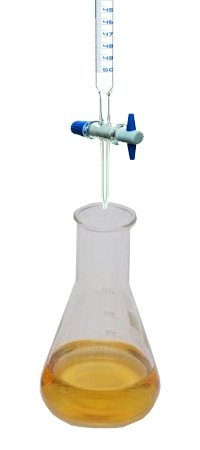Alkalinity is an important measurement for most of the treated water like drinking water. P alkalinity and M alkalinity are the most useful test. They also have known as P value and M value respectably. The neutralize process of alkaline water by acid is refers to the alkalinity. It is directly related to water hardness. This alkalinity values guidance us to applying proper doses of chemicals during water treatment. The salts of carbonate, bi-carbonates, borates, silicates, phosphates and free hydroxyl ions are responsible for alkalinity of natural water. Among of them hydroxyl ions, carbonates and bi-carbonates are the main factor. The P alkalinity and M alkalinity of water are determined by how much acid is taken to lower the pH to the specific value. The result can be expressed as mg/l CaCO3.

P alkalinity test
P Alkalinity is the alkalinity that is determined by using phenolphthalein indicator. This alkalinity is easily measured by titration with a standard solution of N/50 sulfuric acid. During the experiment the water is taken in a conical flex and the acid is taken in the burette. The endpoint pH range of the phenolphthalein indicator is 10-8.3. The neutralization process decreases the pH of the solution and the endpoint changes the color from pink to clear. Some water may not have P value. When the phenolphthalein indicator added into the water then the clear solution indicates the absence of P value.
M alkalinity test procedure
M Alkalinity is the alkalinity that is determined by using Methyl orange indicator. To measure this alkalinity, take 50 ml sample water into a conical flask. Then add 2-3 drops Methyl orange indicator and titration with a standard solution of N/50 H2SO4 solution. The endpoint pH range of the Methyl orange indicator is 4.3 to 3.1. At the end point the color of the Methyl orange changes from yellow to orange (in acid medium it is red color). Take the burette reading and calculate M value by the following equation.
M value = Burette reading (in ml) × 1000/50 ppm
| Sl | Sample volume (ml) | Burette reading (ml) | Result (CaCO3 mg/l) |
| 1 | 50 | 5 | 100 |
| 2 | 50 | 6 | 120 |
| 3 | 50 | 5.5 | 110 |
Normally, we test p value and M value with the one sample. In this case firstly, we measure P alkalinity using phenolphthalein indicator (say Burette reading ‘A’). Just after the test of P value, we added Methyl orange indicator and complete the titration (say Burette reading ‘B’). For M value calculation, the Burette reading will be (A+B).
This test result indicates the type of ions that are present in the water. It may be present as carbonate, bi-carbonates, and hydroxide.
| Condition | Hydroxide | Carbonate | Bicarbonate |
| P = 0 | None | None | M |
| P = M | M | None | None |
| P = 1/2 M | None | M | None |
| P < 1/2 M | None | 2P | M – 2P |
| P > 1/2 M | 2P – M | 2(M – P) | None |
M alkalinity is also known as total alkalinity. The p alkalinity and m alkalinity is useful for research, boilers water, cooling water, pool water treatment etc.
OH alkalinity is also usually performed by adding barium chloride to the sample along with the phenolphthalein. This precipitates out the carbonates. so any alkalinity is confined to hydroxides.
It’s interesting